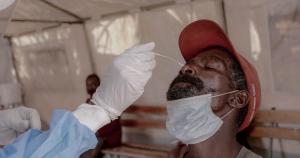Rapid tests up Zimbabwe’s COVID-19 diagnosis
Harare – Zimbabwe has upscaled the use of antigen rapid diagnostic tests to reinforce its COVID-19 response, hitting a daily rate of 4000 tests – a fourfold increase reached within just two months after the method was launched in November 2020.
The rapid tests have been a game changer, according to Dr Raiva Simbi, the Deputy Director Laboratory Services at the Ministry of Health and Child Care. Initially COVID-19 tests were done through the standard polymerase chain reaction in a major laboratory in the capital Harare and later decentralized to the provinces. Even then this was hamstrung by shortages in the supply of reagents due to global competition and longer turn-around time for tests results.
The rapid diagnosis tests have been distributed to clinics in rural areas and results are received 20–30 minutes (at the minimum), a time reduction from up to one week in certain cases when results through the polymerase chain reaction testing had to be sent back to far-flung localities.
“Most of our clinics are able to do tests using the rapid diagnostic test kits,” says Dr Simbi. “The advantages of the turn-around time outweigh the supremacy of the PCR [polymerase chain reaction] in terms of technological advancement. We are very happy that we are covering the whole country in terms of diagnosis of COVID-19.”
At least 600 sites have been set up for the rapid diagnostic tests and more than 1800 health workers from the country’s 10 provinces have been trained in their use. Health worker training is ongoing to reinforce skills particularly in remote areas with no laboratories or laboratory personnel, increasing testing capacity and coverage.
How do they work?
Antigen rapid diagnostic tests detect active SARS- CoV-2 infection and are used as point of care diagnostic tests. They detect the COVID-19 viral proteins, specifically the virus antigen. Rapid diagnostic tests are easy to use and do not require a laboratory or expensive equipment.
Test done with antigen rapid diagnostic tests will most often be positive when viral loads are highest and patients are most infectious – typically 1−3 days prior to the onset of symptoms and during the first 5−7 days after the onset of symptoms – and will become negative as the patient clears the infection and recovers. Antigen rapid diagnostic tests may return false negative results when the viral load falls below the test’s detection limit, as such a negative test result cannot exclude COVID-19 infection and a repeat confirmatory polymerase chain reaction test is necessary particularly in symptomatic patients.
The World Health Organization (WHO) recommends that the antigen rapid tests be used in four scenarios: in suspected outbreaks where there is no access to polymerase chain reaction testing, including in remote, hard-to-reach areas; to trace the extent of an outbreak where at least one case is detected through polymerase chain reaction, including in closed and semi closed settings such as prisons, schools, care homes; among high-risk groups like health workers; and in areas with widespread community transmission.
Broad scope
Antigen rapid diagnostic tests are also useful in other aspects of COVID-19 prevention and control such as supporting treatment, contact tracing, surveillance and outbreak investigations. The tests have enabled wide coverage of testing, timely reporting and has “helped us break the [COVID-19] transmission throughout the country,” says Dr Mugabe Muchaneta, WHO laboratory specialist in Zimbabwe.
The country has to date conducted more than 121 000 antigen rapid diagnostic tests and over 390 000 polymerase chain reaction tests.
“PCR is now well complemented by the [rapid diagnostic tests] and interventions are being done in a timely manner,” says Dr Simbi.
Communications Officer
Tel: + 263 914 31408
Email: juliasw [at] who.int
Communications and marketing officer
Tel: + 242 06 520 65 65 (WhatsApp)
Email: boakyeagyemangc [at] who.int



